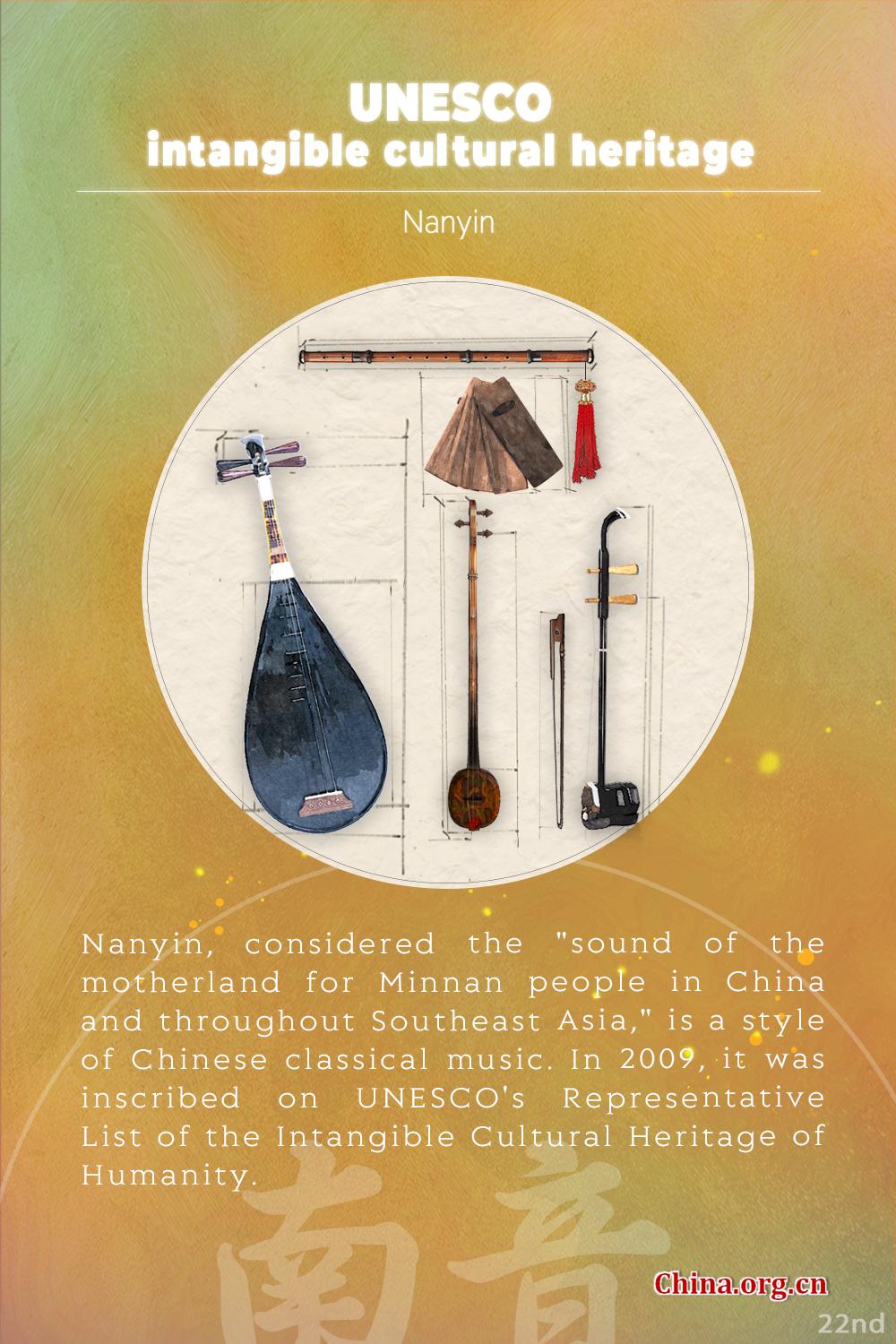
 0 Comment(s)
0 Comment(s) Print
Print E-mail China.org.cn, April 15, 2024
E-mail China.org.cn, April 15, 2024Editor's note: Nanyin, considered the "sound of the motherland for Minnan people in China and throughout Southeast Asia," is a style of Chinese classical music. In 2009, it was inscribed on UNESCO's Representative List of the Intangible Cultural Heritage of Humanity.

Nanyin, which literally means "music of the south," is one of the most ancient styles of music in China. Widely accepted in southeast China's Minnan region, Fujian province, it is recognized as "the sound of the motherland for Minnan people in China and throughout Southeast Asia," according to UNESCO.
The Minnan region refers to the coastal cities of Quanzhou, Xiamen and Zhangzhou, as well as several areas in the city of Longyan. During the Song (960-1279) and Yuan (1271-1368) dynasties, Quanzhou was one of the largest ports in the world, offering many opportunities for local Minnan people to do business with both domestic and overseas partners. When their trade prospered, their local culture, such as Nanyin, thrived accordingly.
During this period, adventurous Minnan people began moving to other nations to explore new opportunities or expand their established businesses. They settled in various Southeast Asian countries, such as Indonesia, Malaysia, Myanmar, Singapore, Vietnam and the Philippines, which gradually became the second hometown of many Minnan people. Nanyin, along with other Minnan cultural elements, was then introduced to these countries and an even wider world.
Today, around 50-60 million people speak the Minnan dialect, at least half of whom live overseas. Therefore, Nanyin, an important part of Minnan people's daily life, is recognized as the sound of their hometown and motherland. Moreover, after several hundred years' business and cultural exchanges, many people in Southeast Asian countries such as Malaysia can also speak fluent Minnan dialect and sing graceful Nanyin, further boosting the development of this intangible cultural heritage.
In 2006, Nanyin was included in the first group of national intangible cultural heritage of China, and in 2009 was added to UNESCO's Representative List of the Intangible Cultural Heritage of Humanity.
Nanyin mainly consists of three types of music, namely, "zhi," "pu" and "qu." Most "zhi"-type musical works are instrumental performances, with only a few having words for singers. "Zhi" includes lyrics, notation and the fingering of pipa, a four-stringed Chinese lute. "Pu" refers to purely instrumental performances, while the dominant "qu"-type, accounting for about 90% of Nanyin works, was mainly created for singing.
There are more than 3,000 existing pieces of Nanyin works, depicting ancient poems, as well as the sceneries, legends, history, love stories and social life of south China. These ancient classical works are usually performed with musical instruments, such as the pipa, dongxiao (an end-blown bamboo flute), erxian (a two-stringed plucked instrument), sanxian (a three-stringed plucked instrument) and bamboo clappers.
No documentary evidence has yet been discovered that conclusively defines the origin of Nanyin. However, according to its tunes, lyrics, notations, instruments and names of songs, historians believe that Nanyin took form as a folk music during the Han dynasty (202 B.C.-A.D. 220), evolved into a royal music in the Tang dynasty (618-907), prospered in the Song dynasty (960-1279) and then developed into various popular genres during the Ming (1368-1644) and Qing (1644-1911) dynasties.
Since the early 20th century, Nanyin musical associations, research centers, troupes and training classes have been established to promote its development. Meanwhile, concerts, shows, competitions and folk custom themed activities are also held frequently in China and around the world. As UNESCO says: "Nanyin is deeply rooted in the social life of the Minnan region. It is performed during spring and autumn ceremonies to worship Meng Chang, the god of music, at weddings and funerals, and during joyful festivities in courtyards, markets and the streets." It then adds that the rich repertoire of Nanyin songs and scores has preserved ancient folk music and poems, as well as influenced opera, puppet theater and other performing art traditions.
On Dec. 8, 2023, the 5th Maritime Silk Road International Arts Festival was held in Quanzhou, bringing together more than 1,600 artists and guests from 43 countries and regions. As part of the festival, a symposium focusing on Nanyin was held and attended by representatives from 13 associations in China and countries such as Singapore, Malaysia, the Philippines and Indonesia. Experts and artists at the meeting discussed the inheritance, innovation and future of Nanyin related culture, further promoting the development of this form of intangible cultural heritage.
Discover more treasures from China on UNESCO's ICH list:
• 2022: Traditional tea processing
• 2020: Wangchuan ceremony, taijiquan
• 2018: Lum medicinal bathing of Sowa Rigpa
• 2016: Twenty-four solar terms
• 2013: Abacus-based Zhusuan
• 2012: Training plan for Fujian puppetry performers
• 2011: Shadow puppetry, Yimakan storytelling
• 2010: Peking opera, acupuncture and moxibustion, wooden movable-type printing, watertight-bulkhead technology of Chinese junks, Meshrep
• 2009: Yueju opera, Xi'an wind and percussion ensemble, traditional handicrafts of making Xuan paper, traditional firing techniques of Longquan celadon, Tibetan opera, sericulture and silk craftsmanship, Regong arts, Nanyin

Go to Forum >>0 Comment(s)